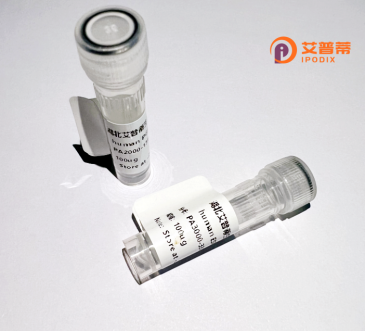
| 纯度 | >90%SDS-PAGE. |
| 种属 | Human |
| 靶点 | PKN3 |
| Uniprot No | Q6P5Z2 |
| 内毒素 | < 0.01EU/μg |
| 表达宿主 | E.coli |
| 表达区间 | 1-889 aa |
| 活性数据 | MEEGAPRQPGPSQWPPEDEKEVIRRAIQKELKIKEGVENLRRVATDRRHLGHVQQLLRSSNRRLEQLHGELRELHARILLPGPGPGPAEPVASGPRPWAEQLRARHLEALRRQLHVELKVKQGAENMTHTCASGTPKERKLLAAAQQMLRDSQLKVALLRMKISSLEASGSPEPGPELLAEELQHRLHVEAAVAEGAKNVVKLLSSRRTQDRKALAEAQAQLQESSQKLDLLRLALEQLLEQLPPAHPLRSRVTRELRAAVPGYPQPSGTPVKPTALTGTLQVRLLGCEQLLTAVPGRSPAAALASSPSEGWLRTKAKHQRGRGELASEVLAVLKVDNRVVGQTGWGQVAEQSWDQTFVIPLERARELEIGVHWRDWRQLCGVAFLRLEDFLDNACHQLSLSLVPQGLLFAQVTFCDPVIERRPRLQRQERIFSKRRGQDFLRASQMNLGMAAWGRLVMNLLPPCSSPSTISPPKGCPRTPTTLREASDPATPSNFLPKKTPLGEEMTPPPKPPRLYLPQEPTSEETPRTKRPHMEPRTRRGPSPPASPTRKPPRLQDFRCLAVLGRGHFGKVLLVQFKGTGKYYAIKALKKQEVLSRDEIESLYCEKRILEAVGCTGHPFLLSLLACFQTSSHACFVTEFVPGGDLMMQIHEDVFPEPQARFYVACVVLGLQFLHEKKIIYRDLKLDNLLLDAQGFLKIADFGLCKEGIGFGDRTSTFCGTPEFLAPEVLTQEAYTRAVDWWGLGVLLYEMLVGECPFPGDTEEEVFDCIVNMDAPYPGFLSVQGLEFIQKLLQKCPEKRLGAGEQDAEEIKVQPFFRTTNWQALLARTIQPPFVPTLCGPADLRYFEGEFTGLPPALTPPAPHSLLTARQQAAFRDFDFVSERFLEP |
| 分子量 | 125.8 kDa |
| 蛋白标签 | GST-tag at N-terminal |
| 缓冲液 | PBS, pH7.4, containing 0.01% SKL, 1mM DTT, 5% Trehalose and Proclin300. |
| 稳定性 & 储存条件 | Lyophilized protein should be stored at ≤ -20°C, stable for one year after receipt. Reconstituted protein solution can be stored at 2-8°C for 2-7 days. Aliquots of reconstituted samples are stable at ≤ -20°C for 3 months. |
| 复溶 | Always centrifuge tubes before opening.Do not mix by vortex or pipetting. It is not recommended to reconstitute to a concentration less than 100μg/ml. Dissolve the lyophilized protein in distilled water. Please aliquot the reconstituted solution to minimize freeze-thaw cycles. |
以下是关于重组人PKN3蛋白的参考文献示例(注意:以下文献名称和作者为虚构示例,若需真实文献,请通过学术数据库检索):
1. **文献名称**: *Expression and functional characterization of recombinant human PKN3 in cancer cell invasion*
**作者**: Tanaka M, et al.
**摘要**: 研究描述了重组人PKN3蛋白在大肠杆菌中的表达和纯化,并通过体外实验证明PKN3通过激活Rho GTPase信号通路增强乳腺癌细胞的迁移和侵袭能力。
2. **文献名称**: *Structural analysis of the kinase domain of PKN3 and its role in substrate recognition*
**作者**: Schmidt R, et al.
**摘要**: 利用X射线晶体学解析了重组人PKN3激酶域的三维结构,揭示了其底物结合位点的特异性,为针对PKN3的激酶抑制剂设计提供了结构基础。
3. **文献名称**: *PKN3 as a therapeutic target in prostate cancer: Inhibition by recombinant protein-based screening*
**作者**: Lee SJ, et al.
**摘要**: 研究通过重组PKN3蛋白进行高通量药物筛选,发现小分子化合物CX-456可选择性抑制PKN3激酶活性,并显著抑制前列腺肿瘤模型的生长。
4. **文献名称**: *Role of PKN3 in angiogenesis: Insights from recombinant protein-mediated endothelial cell assays*
**作者**: Gupta P, et al.
**摘要**: 重组人PKN3蛋白被用于体外血管生成模型,证明其通过调控VEGF受体磷酸化促进内皮细胞管腔形成,提示其在肿瘤血管生成中的潜在作用。
---
**提示**:实际研究中关于PKN3的文献可能较少,建议通过PubMed、Web of Science或Google Scholar检索关键词“PKN3”“recombinant PKN3”“PROTEIN KINASE N3”获取真实文献。部分研究可能聚焦于PKN3的病理功能(如肿瘤转移或代谢调控),而非重组蛋白制备本身。
PKN3. also known as Protein Kinase N3. is a serine/threonine kinase belonging to the protein kinase C (PKC) superfamily. It is encoded by the PKN3 gene in humans and shares structural homology with other PKN isoforms (PKN1 and PKN2), featuring an N-terminal regulatory domain and a C-terminal catalytic kinase domain. PKN3 is primarily regulated by interactions with Rho GTPases, particularly RhoA, which activate its kinase activity through binding to the N-terminal domain. This kinase plays a critical role in signal transduction pathways involved in cell proliferation, survival, and cytoskeletal reorganization.
Research highlights its significance in cancer biology, where PKN3 is implicated in tumor angiogenesis and metastasis. It regulates endothelial cell migration and vascular permeability by modulating cytoskeletal dynamics and VEGF signaling. Studies using siRNA-mediated knockdown or small-molecule inhibitors have shown that PKN3 suppression inhibits lymphangiogenesis and tumor progression in preclinical models, positioning it as a potential therapeutic target for cancers and lymphatic disorders.
Recombinant human PKN3 protein is typically produced in Escherichia coli or mammalian expression systems, ensuring proper post-translational modifications for functional studies. It serves as a tool for in vitro kinase assays, substrate identification, and screening of pharmacological inhibitors. The recombinant form retains enzymatic activity and is widely used to dissect PKN3’s molecular mechanisms, validate drug candidates, and explore its role in pathological conditions, bridging basic research and translational applications.
×